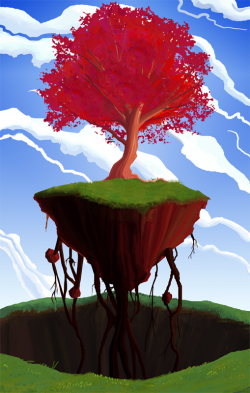Elder Tree
| Eldus honamti Native: Elder Tree Other: Aldyor Tree |
||
|---|---|---|
| - | Kingdom: | Plantae |
| - | Order: | Magae |
| - | Family: | Relage |
| - | Genus: | Eldus |
| - | Species: | E. honamti |
| a. | Discovered by Elda E. Tereyo | |
These organisms take on a shape similar to other trees but have a curious property that allows them to float. As they grow from a seedling the sapling gradually lifts itself up from the world, taking a large clump of earth with it. This clump of dirt is not required for the livelihood of the plant but instead only the connection of the roots must be maintained. These roots tether the tree to the planet; if they are cut the Elder Tree rises away and eventually crashes back to the surface as it dies.
Description
It is a large sprawling tree with a thick center trunk and spindly branches that split off at forty to fifty feet high. It generally grows to be 250 feet tall though exceptional specimens have been found up to 320 feet in height. The trunk is never thicker in diameter than 5 feet as the normal stresses of Nalan's pull do not seem to affect the organism. Shoots are a dark brownish-red and the adult bark is a light pale red. Throughout the tree's life it produces vivid red leaves that do not fall or die with the changing seasons, instead continuously adding more to its canopy.
Ecology
Eldus honamti has been found throughout the world in many soil types. It does not seem to have any strict requirements for its growth. However, these trees will not grow within 100mp of another of its kind.
Local vegetation thrives closest to the base of an Elder Tree and they are generally the focal points for large farms.
Klack Birds have been known to nest in the Elder Tree and bear a plumage of feathers with colors strikingly similar to that of the honamti foliage.
Elder Trees in Folk Lore
Many people believe that the Elder Tree is a holy plant that shows the presence of gods. The trees have been deemed off limits in nearly every kingdom and continent of Nalan. This is largely due to the death of local crops if the plant is harmed, but religious reverence also forbids any disturbance. Despite this, some people still work to illegally harvest its roots and leaves from the canopy.
